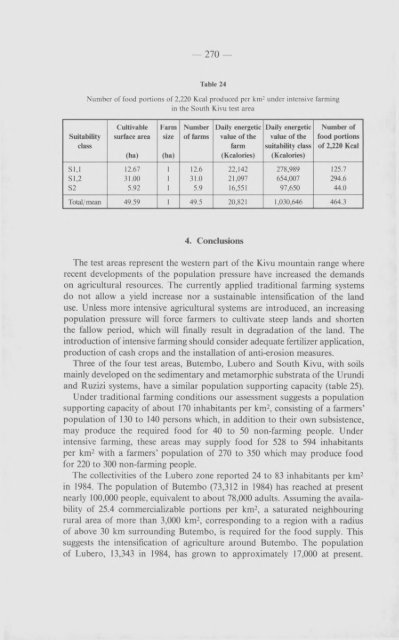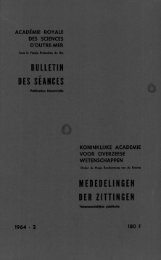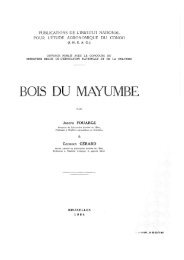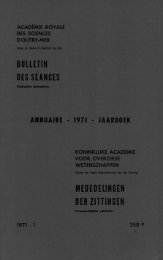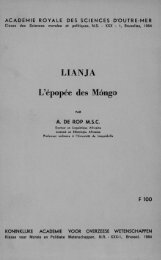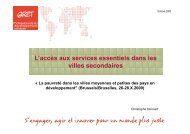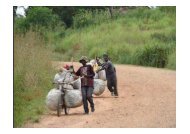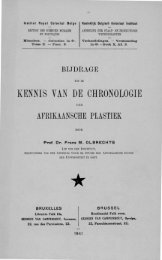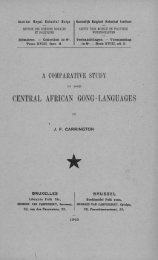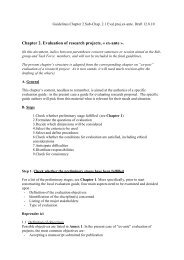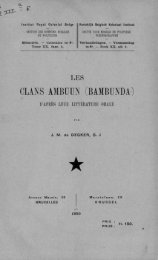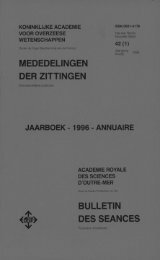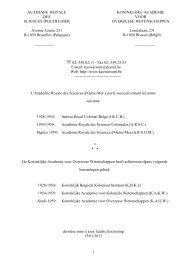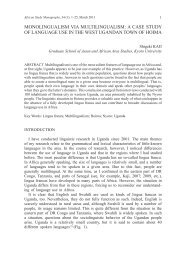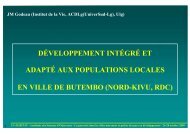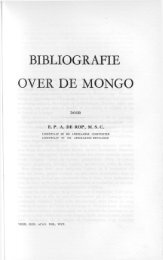mededelingen der zittingen bulletin des seances - Royal Academy ...
mededelingen der zittingen bulletin des seances - Royal Academy ...
mededelingen der zittingen bulletin des seances - Royal Academy ...
Create successful ePaper yourself
Turn your PDF publications into a flip-book with our unique Google optimized e-Paper software.
Suitability<br />
class<br />
Table 24<br />
N um ber of food portions of 2,220 Kcal produced per km 2 un<strong>der</strong> intensive farming<br />
in the South Kivu test area<br />
Cultivable<br />
surface area<br />
(ha)<br />
Farm<br />
size<br />
(ha)<br />
Number<br />
of farms<br />
Daily energetic<br />
value of the<br />
farm<br />
(Kcalories)<br />
Daily energetic<br />
value of the<br />
suitability class<br />
(Kcalories)<br />
Number of<br />
food portions<br />
of 2,220 Kcal<br />
S l,l 12.67 1 12.6 22,142 278,989 125.7<br />
S I,2 31.00 1 31.0 21,097 654,007 294.6<br />
S2 5.92 1 5.9 16,551 97,650 44.0<br />
Total/ mean 49.59 1 49.5 20,821 1,030,646 464.3<br />
4. Conclusions<br />
The test areas represent the western part of the Kivu mountain range where<br />
recent developments of the population pressure have increased the demands<br />
on agricultural resources. The currently applied traditional farming systems<br />
do not allow a yield increase nor a sustainable intensification of the land<br />
use. Unless more intensive agricultural systems are introduced, an increasing<br />
population pressure will force farmers to cultivate steep lands and shorten<br />
the fallow period, which will finally result in degradation of the land. The<br />
introduction of intensive farming should consi<strong>der</strong> adequate fertilizer application,<br />
production of cash crops and the installation of anti-erosion measures.<br />
Three of the four test areas, Butembo, Lubero and South Kivu, with soils<br />
mainly developed on the sedimentary and metamorphic substrata of the Urundi<br />
and Ruzizi systems, have a similar population supporting capacity (table 25).<br />
Un<strong>der</strong> traditional farming conditions our assessment suggests a population<br />
supporting capacity of about 170 inhabitants per km2, consisting of a farmers’<br />
population of 130 to 140 persons which, in addition to their own subsistence,<br />
may produce the required food for 40 to 50 non-farming people. Un<strong>der</strong><br />
intensive farming, these areas may supply food for 528 to 594 inhabitants<br />
per km2 with a farmers’ population of 270 to 350 which may produce food<br />
for 220 to 300 non-farming people.<br />
The collectivities of the Lubero zone reported 24 to 83 inhabitants per km2<br />
in 1984. The population of Butembo (73,312 in 1984) has reached at present<br />
nearly 100,000 people, equivalent to about 78,000 adults. Assuming the availability<br />
of 25.4 commercializable portions per km2, a saturated neighbouring<br />
rural area of more than 3,000 km2, corresponding to a region with a radius<br />
of above 30 km surrounding Butembo, is required for the food supply. This<br />
suggests the intensification of agriculture around Butembo. The population<br />
of Lubero, 13,343 in 1984, has grown to approximately 17,000 at present.


